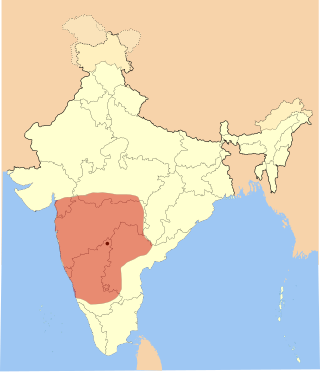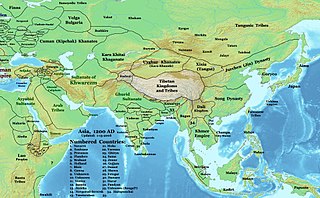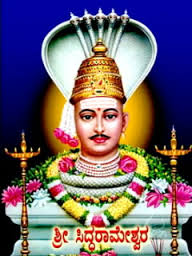
Lingayatism is a Hindu denomination based on Shaivism. Initially known as Veerashaivas, since the 12th-century adherents of this faith are known as Lingayats.

Basava (1131–1196), also called Basaveshwara and Basavanna, was an Indian philosopher, poet, Lingayat social reformer in the Shiva-focused bhakti movement, and a Hindu Shaivite social reformer during the reign of the Kalyani Chalukya/Kalachuri dynasty. Basava was active during the rule of both dynasties but reached the peak of his influence during the rule of King Bijjala II in Karnataka, India.

Kannada literature is the corpus of written forms of the Kannada language, a member of the Dravidian family spoken mainly in the Indian state of Karnataka and written in the Kannada script.

Akka Mahadevi was one of the early poets of Kannada literature and a prominent person in the Lingayat Shaiva sect in the 12th century. Her 430 extant Vachana poems, and the two short writings called Mantrogopya and the Yogangatrividh are considered her most notable contribution to Kannada literature. She composed fewer poems than other saints of the movement. The term Akka is an honorific given to her by great saints such as Basavanna, Siddharama and Allamaprabhu and an indication of her high place in the spiritual discussions held at the "Anubhava Mantapa". She is seen as an inspirational woman in Kannada literature and in the history of Karnataka. She considered the god Shiva as her husband,.

The Western Chalukya Empire ruled most of the western Deccan, South India, between the 10th and 12th centuries. This Kannadiga dynasty is sometimes called the Kalyani Chalukya after its regal capital at Kalyani, today's Basavakalyan in the modern Bidar District of Karnataka state, and alternatively the Later Chalukya from its theoretical relationship to the 6th-century Chalukya dynasty of Badami. The dynasty is called Western Chalukyas to differentiate from the contemporaneous Eastern Chalukyas of Vengi, a separate dynasty. Prior to the rise of these Chalukyas, the Rashtrakuta empire of Manyakheta controlled most of Deccan and Central India for over two centuries. In 973, seeing confusion in the Rashtrakuta empire after a successful invasion of their capital by the ruler of the Paramara dynasty of Malwa, Tailapa II, a feudatory of the Rashtrakuta dynasty ruling from Bijapur region defeated his overlords and made Manyakheta his capital. The dynasty quickly rose to power and grew into an empire under Someshvara I who moved the capital to Kalyani.

Basavakalyana is a historical city and municipal council in the Bidar District of the Indian state of Karnataka. It was the capital of two dynasties — Kalyani Chalukya and Kalachuris of Kalyani. It is famous for the world's tallest Basavanna statue, which stands 108 feet high. It is one of the major cities and industrial hubs of Bidar district.

Allamaprabhu was a 12th-century mystic-saint and Vachana poet of the Kannada language, propagating the unitary consciousness of Self and Shiva. Allamaprabhu is one of the celebrated poets and the patron saint of the Lingayata movement that reshaped medieval Karnataka society and popular Kannada literature. He is included among the "Trinity of Lingayathism", along with Basavanna, the founder of the movement, and Akka Mahadevi, the most prominent woman poet.
Channabasavanna also known as " Guru Channabasaveshwara " was Basava's nephew and one of the foremost Sharanas of the 12th century. He, along with Basava, Allama Prabhu and Akka Mahadevi, played a pivotal role in the propagation of the Lingayat faith. He was the youngest among the sharana leaders and grew up in the household of Basavanna as he was the son of Nagalambike, Basava's own sister. He also wrote the Karana Hasuge which is one of the most sacred texts of the Lingayats, among many vachanas. He propounded the "shatasthala" philosophy associated with the six holy places of Veerashaiva Lingayat creed. He succeeded to the Shunya Simhasana at Anubhava Mantapa, Kalyana after the departure of Allama Prabhu, circa 1162ad. His young shoulders carried on the legacy of Basava after the latter's departure to Kudalasangama in 1162ad. He is credited to have systematised the entire manual of simple rituals for the followers. He was a strong advocate of the Ishtalinga wearing and expounded the material as well as the esoteric meaning of that divine symbol. He held together the nascent group of Shivasharanas and Jangmas in tumultuous times of clashes with the orthodox Brahmins and heretic Jains. Following the assassination of Kalachuri King Bijjala II in 1167 A.D, Channabasava along with his followers migrated to Ulavi safeguarding the Vachana literature. He attained Samadhi state there at the age of 25 passing on the leadership of the movement to Siddarama.

Anubhava Mantapa, established by Basavanna in the 12th century C.E. is a religious complex located in Tipranth area, Basavakalyan in Bidar district of Karnataka. It is the first religious parliament in the world, whose literal meaning is "experience pavilion", and was an academy of mystics, saints and philosophers of the lingayat faith in the 12th century. It was the fountainhead of all religious and philosophical thought pertaining to the lingayat. It was presided over by the mystic Allama Prabhu and numerous Sharanas from all over Karnataka and other parts of India were participants. This institution was also the fountainhead of the Vachana literature which was used as the vector to propagate Veerashaiva religious and philosophical thought. Other giants of veerashaiva theosophy like Akka Mahadevi, Channabasavanna and Basavanna himself were participants in the Anubhava Mantapa. The Anubhava Mantapa is also called the Mahaamane. PM Narendra Modi have made a reference of Anubhava Mantapa in his speech during the inauguration of new parliamentary building, he also mentioned that the Anubhava Mantapa established by Basavanna in the 12th century is the foundation for parliamentary democracy.

Hoysala literature is the large body of literature in the Kannada and Sanskrit languages produced by the Hoysala Empire (1025–1343) in what is now southern India. The empire was established by Nripa Kama II, came into political prominence during the rule of King Vishnuvardhana (1108–1152), and declined gradually after its defeat by the Khalji dynasty invaders in 1311.

A large body of Western Chalukya literature in the Kannada language was produced during the reign of the Western Chalukya Empire in what is now southern India. This dynasty, which ruled most of the western Deccan in South India, is sometimes called the Kalyani Chalukya dynasty after its royal capital at Kalyani, and sometimes called the Later Chalukya dynasty for its theoretical relationship to the 6th-century Chalukya dynasty of Badami. For a brief period (1162–1183), the Kalachuris of Kalyani, a dynasty of kings who had earlier migrated to the Karnataka region from central India and served as vassals for several generations, exploited the growing weakness of their overlords and annexed the Kalyani. Around 1183, the last Chalukya scion, Someshvara IV, overthrew the Kalachuris to regain control of the royal city. But his efforts were in vain, as other prominent Chalukya vassals in the Deccan, the Hoysalas, the Kakatiyas and the Seunas destroyed the remnants of the Chalukya power.
Chamarasa was a 15th century Virashaiva poet in the Kannada language, during the reign of Vijayanagar Empire, a powerful empire in Southern India during 14th - 16th centuries. A contemporary and competitor to a noted Brahmin Kannada poet Kumara Vyasa, Chamarasa was patronised by King Deva Raya II. The work is in 25 chapters (gatis) comprising 1111 six-line verses (arupadi).
Medieval Kannada literature covered a wide range of subjects and genres which can broadly be classified under the Jain, Virashaiva, Vaishnava and secular traditions. These include writings from the 7th century rise of the Badami Chalukya empire to the 16th century, coinciding with the decline of Vijayanagara Empire. The earliest known literary works until about the 12th century CE were mostly authored by the Jainas along with a few works by Virashaivas and Brahmins and hence this period is called the age of Jain literature,. The 13th century CE, to the 15th century CE, saw the emergence of numerous Virashaiva and Brahminical writers with a proportional decline in Jain literary works. Thereafter, Virashaiva and Brahmin writers have dominated the Kannada literary tradition. Some of the earliest metres used by Jain writers prior to 9th century include the chattana, bedande and the melvadu metres, writings in which have not been discovered but are known from references made to them in later centuries. Popular metres from the 9th century onwards when Kannada literature is available are the champu-kavyas or just champu, vachanasangatya, shatpadi, ragale, tripadi, and kavya.

Vijayanagara literature in Kannada is the body of literature composed in the Kannada language of South India during the ascendancy of the Vijayanagara Empire which lasted from the 14th through the 16th century. The Vijayanagara empire was established in 1336 by Harihara I and his brother Bukka Raya I. Although it lasted until 1664, its power declined after a major military defeat by the Shahi Sultanates in the battle of Talikota in 1565. The empire is named after its capital city Vijayanagara, whose ruins surround modern Hampi, now a World Heritage Site in Karnataka.
Harihara was a noted Kannada poet and writer in the 12th century. A native of Halebidu in modern Hassan district, he came from a family of accountants (Karnikas) and initially served in that capacity in the court of Hoysala King Narasimha I. Later, he moved to Hampi and authored many landmark classics. Among his important writings, the Girijakalyana written in champu metre is considered one of the enduring classics of Kannada language.
Palkuriki Somanatha was one of the most noted Telugu language writers of the 12th or 13th century. He was also an accomplished writer in the Kannada and Sanskrit languages and penned several classics in those languages. He was a Veerashaiva a follower of the 12th century social reformer Basava and his writings were primarily intended to propagate this faith. He was a well acclaimed Shaiva poet.

Siddheshwar also known as Siddharameshwar and Siddharama was one among the five acharya ("saint") of the Veerashaiva faith. Siddheshwar was a great contributor to Lingayat sampradaya of Hinduism. He was a great mystic and a Kannada poet who was a part of Basavanna's Lingayat revolution during the 12th century. His philosophy was one of service to mankind, the path of Shivayoga. Siddarama was instrumental in saving the vachana literature from destruction. Shri Siddharameshwar was born in Solapur City of Maharashtra.

The Basava Purana is a 13th-century Telugu epic poem. It was written by Palkuriki Somanatha. It is a sacred text of Lingayat. The epic poem narrates the life story of philosopher and social reformer Basava, the founder of Lingayat. He is also known by several other names such as Basavanna, Basaweshwara, Basavesha, and Basavaraja. It is also an anthology of several Lingayat saints and their philosophies. In contrast to campu style, Somanatha adopted the desi (native) style and composed the purana in dwipada (couplets), a meter popular in oral tradition and closely related to folk songs.
The term Shiva Sharanas/Sarana can be roughly explained as devotees of Shiva. The 12th century Vachanakaras are also known by this name. Sharana is somebody who has surrendered oneself to the will of the Lord. Sharanu is derived from this term and it denotes the action of surrendering to or an act of respecting others. This term is seen in many Vachanas composed by the Vachanakaras namely Basavanna, Allama Prabhu, Akka Mahadevi and Madivala Machideva. The Vachanakaras, surrendering themselves to the will of Lord Shiva, have glorified and praised the forms of Lord Shiva. Not only this, the term signifies profound philosophical meanings. A sharana is given a prime place in the schematic world of Vachanas. An example for elevated position of a sharana is the following vachana of Basavanna.













